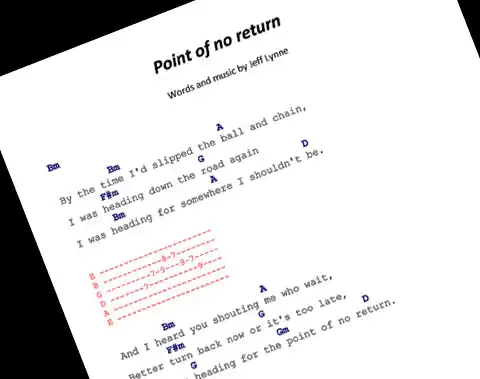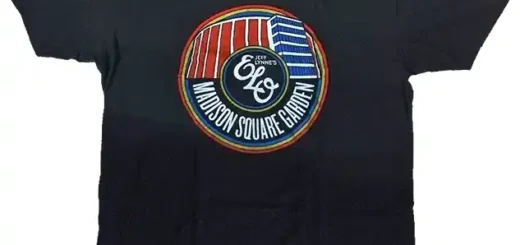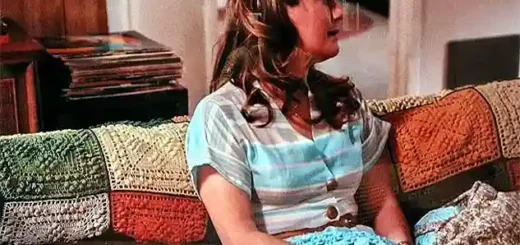Tablatura POINT OF NO RETURN
Nuestro buen amigo SALVADOR MARCH nos envía para su publicación en nuestra web la tablatura del nuevo tema de JEFF LYNNE «POINT OF NO RETURN» realizada por él mismo, a la que adjuntamos el texto que la acompaña.

Lógicamente, para los profanos todo esto les sonará a chino; pero voy a tratar de explicar un poco el proceso. Después de escuchar y re-escuchar mUUUUUchas veces el tema, de «aporrear» literalmente la guitarra, de tirarme de los pocos pelos que me van quedando, etc…, por fín he podido sacar los acordes básicos de esta maravillosa canción. He preferido poner los acordes en Cifrado Americano (o anglosajón) para mayor comprensión de todos los músicos; que en los clásicos Do, Re, Mi, etc…
Para los que les pica la curiosidad y quieran saber eso del «cifrado americano» que es lo que es, paso a explicároslo: cuando los ingleses empezaron a escribir música no adoptaron el sistema latino (Do, Re, Mi, etc…), si no que inventaron uno propio basado en la 7 primeras letras del abecedario (desde la A hasta la G); y en lugar de empezar por Do, empezaron por La. Por lo que la transcripción resultante es:
A = La
B = Si
C = Do
D = Re
E = Mi
F = Fa
G = Sol
Luego el tema de la simbología de acordes menores, sostenidos, bemoles, séptimas, novenas, etc..(m, #, b, 7, 9, etc…). es idéntico en ambos cifrados. Así pues, si encontramos por ejemplo Dm, significa Rem (Re menor). Un ejemplo que aparece en la canción: F#m, equivale a Fa sostenido menor. Espero haberme explicado con claridad. Por otro lado se encuentra el punteo.
Ejemplo:
E ————————-
B ————8-7——–
G ———7-9—9-7—
D ——-7———-9—-
A ————————-
E ————————-
Las distintas líneas representan las 6 cuerdas de la guitarra en orden descendente de la más fina (la de arriba) a la más gruesa (la de abajo). Las letras que aparecen a la izquierda es la distinta afinación de cada cuerda. En este caso es la afinación estándar.
Los números indican en que traste está la nota que se debe tocar. Por orden de lectura, vemos que la primera nota que hay que tocar está en la cuarta cuerda (en orden descendente) y en el traste 7.
Desde ELO ESPAÑA nuestro agradecimiento a SALVADOR MARCH por su consideración hacia nosotros y su disposición al ofrecernos su trabajo.
ELOSPAIN:
Our good friend SALVADOR MARCH has sent us, for publication on our website, the tablature for JEFF LYNNE's new song "POINT OF NO RETURN," which he created himself. Here is the accompanying text:
Logically, for non-musicians, all this may sound like Chinese, but I'll try to explain the process a bit. After listening and re-listening to the song many times, literally "banging" on the guitar, pulling out the few hairs I have left, etc., I've finally been able to figure out the basic chords of this wonderful song. I preferred to put the chords in American (or Anglo-Saxon) notation for better understanding by all musicians, rather than using the classic Do, Re, Mi, etc.
For those curious about this "American notation" and want to know what it is, let me explain: when the English started writing music, they did not adopt the Latin system (Do, Re, Mi, etc.), but invented their own based on the first 7 letters of the alphabet (from A to G). Instead of starting with Do, they started with La. So, the resulting transcription is:
A = La
B = Si
C = Do
D = Re
E = Mi
F = Fa
G = Sol
Then the issue of chord symbols, sharps, flats, sevenths, ninths, etc. (m, #, b, 7, 9, etc.) is identical in both notations. So, if we find, for example, Dm, it means Re minor. An example that appears in the song: F#m, equals Fa sharp minor. I hope I have explained it clearly. On the other hand, there is the solo.
Example:
E -------------------------
B ------------8-7--------
G ---------7-9---9-7---
D -------7----------9----
A -------------------------
E -------------------------
The different lines represent the 6 strings of the guitar in descending order from the thinnest (top) to the thickest (bottom). The letters on the left indicate the different tuning of each string. In this case, it is standard tuning.
The numbers indicate which fret the note to be played is on. In reading order, we see that the first note to be played is on the fourth string (in descending order) and on the 7th fret.
From ELO ESPAÑA, our thanks to SALVADOR MARCH for his consideration towards us and his willingness to share his work.



